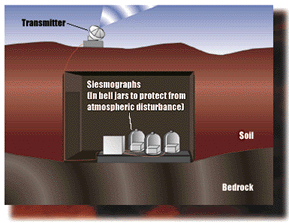
Within the first microsecond of a subterranean blast, a fiery bubble of vaporized rock forms at pressures of several million atmospheres. The expanding gas forces open a cavity, while the shock wave pulverizes rock as it expands into the surrounding earth, then travel for hundreds of miles through the planet. Seismographic stations feel the waves as they pass beneath.
Ideally, says Peter Marshall, a seismologist with Britain's Atomic Weapons Establishment, they would like to be able to do the same for covert 1 kT blasts. | ||
 |
